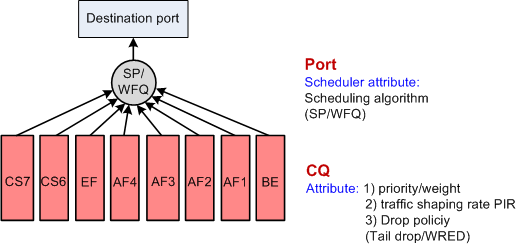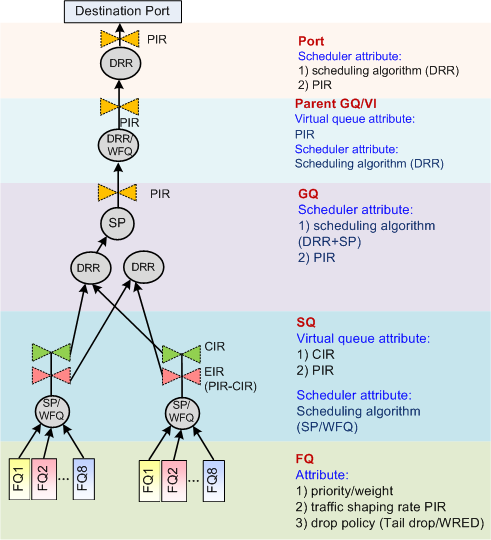Introduction to HQoS
Different from conventional QoS that performs queue scheduling based on interfaces, HQoS identifies different users and different services of the same user on a single interface.
Hierarchical Quality of Service (HQoS) is a technology that uses a queue scheduling mechanism to guarantee the bandwidth of multiple services of multiple users in the DiffServ model.
Traditional QoS performs 1-level traffic scheduling. The device can distinguish services on an interface but cannot identify users. Packets of the same priority are placed into the same queue on an interface and compete for the same queue resources. HQoS uses multi-level scheduling to distinguish user-specific or service-specific traffic and provide differentiated bandwidth management.
Scheduling Architecture of NetEngine 8000 Fs
Figure 1 shows class queues (CQs) and port schedulers. NetEngine 8000 Fs not configured with HQoS have only CQs and port schedulers.
As shown in Figure 2, when HQoS is configured, a router specifies a buffer for flow queues that require hierarchical scheduling and performs a round of multi-layer scheduling for these flow queues. After that, the router puts HQoS traffic and non-HQoS traffic together into the CQ for unified scheduling.
-
A leaf node is used to buffer data flows of one priority for a user. Data flows of each user can be classified into one to eight priorities. Each user can use one to eight FQs. Different users cannot share FQs. A traffic shaping value can be configured for each FQ to restrict the maximum bandwidth.
FQs and CQs share the following configurable attributes:
- Queue priority and weight
- PIR
- Drop policy, including tail drop and WRED
Transit node: subscriber queue
An SQ indicates a user (for example, a VLAN, LSP, or PVC). You can configure the CIR and PIR for each SQ.
Each SQ corresponds to eight FQ priorities, and one to eight FQs can be configured. If an FQ is idle, other FQs can consume the bandwidth of the FQ, but the bandwidth that can be used by an FQ cannot exceed the PIR of the FQ.
An SQ functions as both a scheduler and a virtual queue to be scheduled.
- As a scheduler: schedules multiple FQs. Priority queuing (PQ), Weighted Fair Queuing (WFQ), or low priority queuing (LPQ) applies to an FQ. The FQs with the service class EF, CS6, and CS7 use SP scheduling by default. The flow queues with the service class BE, AF1, AF2, AF3, and AF4 use WFQ scheduling by default, with the weight 10:10:10:15:15.
- As a virtual queue to be scheduled: is allocated two attributes, CIR and PIR. Using metering, the SQ traffic is divided into two parts, the part within the CIR and the burst part within the PIR. The former part is paid by users, and the latter part is also called the excess information rate (EIR). The EIR can be calculated using this format: EIR = PIR - CIR. The EIR refers to the burst traffic rate, which can reach a maximum of PIR.
-
To simplify operation, you can define multiple users as a GQ, which is similar to a BGP peer group that comprises multiple BGP peers. For example, all users that require the same bandwidth or all premium users can be configured as a GQ.
A GQ can be bound to multiple SQs, but an SQ can be bound only to one GQ.
A GQ schedules SQs. DRR is used to schedule the traffic within CIR between SQs. If any bandwidth is remaining after the first round, DRR is used to schedule the EIR traffic. The bandwidth of CIR is preferentially provided, and the burst traffic exceeded the PIR is dropped. Therefore, if the bandwidth of a GQ reaches the PIR, the CIR of each SQ in the GQ can be guaranteed, and the maximum bandwidth that each SQ can obtain is its own PIR.
In addition, a GQ, as a root node, can be configured with a PIR attribute to restrict the sum rate of multiple member users of the GQ. All users in this GQ are restricted by the PIR. The PIR of a GQ is used for rate limit but does not provide bandwidth guarantee. The PIR of a GQ is recommended to be greater than the sum of CIRs of all its member SQs. Otherwise, a user (SQ) cannot obtain sufficient bandwidth.
The following example illustrates the relationship between an FQ, SQ, and GQ.
In an example, 20 residential users live in a building. Each residential user purchases the bandwidth of 20 Mbit/s. To guarantee the bandwidth, an SQ with both the CIR and PIR of 20 Mbit/s is created for each residential user. The PIR here also restricts the maximum bandwidth for each residential user. With the subscription of VoIP and IPTV services as well as the HSI services, carriers promote a new bandwidth package with the value-added services (including VoIP and IPTV) added but the bandwidth 20 Mbit/s unchanged. Each residential user can use VoIP, IPTV, and HSI services.
To meet such bandwidth requirements, HQoS is configured as follows:
- Configure three FQs, corresponding to three services (VoIP, IPTV, and HSI), and set a CIR and PIR for each service.
- Altogether 20 SQs are configured for 20 residential users. The CIR and PIR are configured for each SQ.
- One GQ is configured for the whole building and corresponds to 20 residential users. The sum bandwidth of the 20 residential users is actually the PIR of the GQ. Each of the 20 residential users uses services individually, but the sum bandwidth of them is restricted by the PIR of the GQ.
The hierarchy model is as follows:
- FQs are used to distinguish services of a user and control bandwidth allocation among services.
- SQs are used to distinguish users and restrict the bandwidth of each user.
- GQs are used to distinguish user groups and control the traffic rate of twenty SQs.
FQs enable bandwidth allocation among services. SQs distinguish each user. GQs enable the CIR of each user to be guaranteed and all member users to share the bandwidth.
The bandwidth exceeds the CIR is not guaranteed because it is not paid by users. The CIR must be guaranteed because the CIR has been purchased by users. As shown in Figure 2, the CIR of users is marked, and the bandwidth is preferentially allocated to guarantee the CIR. Therefore, the bandwidth of CIR will not be preempted by the burst traffic exceeded the service rates.
On NetEngine 8000 Fs, HQoS uses different architectures to schedule upstream or downstream queues.

